Hummingbirds are interesting birds to watch. In the family Trochilidae, there are about 360 species of hummingbirds known worldwide. Only a few of these species migrate to Ohio. Hummingbirds are small, and their lengths range from 5cm to 23cm. Hummingbirds, like most birds, are found in areas with tropical climates, but there are rare occasions when they migrate to other countries. These birds love to feed on nectar, but will also feed on insects. In this article, we’re taking a closer look at the hummingbirds in Ohio that you can expect to see.
Hummingbirds have very bold colors, and are generally easy to spot and identify. They do not view humans as harmful, and come closer to them to feed, allowing humans to enjoy the birds’ beauty. Here is a list of hummingbirds in Ohio you are likely to spot in your backyard.

1.) Ruby-throated Hummingbird
The ruby-throated hummingbird is a regular visitor to Ohio. They arrive in the period of late April and early May. Its’ length ranges from 7-9cm and 8-11cm in wingspan. Adult ruby-throated hummingbirds appear grayish white from below and metallic green above, and almost black wings. The bill is curved downwards. Males have a throat patch that is iridescent red.
Their feet and toes are small, and it has to shuffle to move along on a branch but can scratch its neck and head using its feet. They are fast when flying and flexible in modes of flying.
Ruby-throated hummingbirds are famous for searching nectars on flowers. They also feed on insects and spiders. Orange and red flowers with a tubular shape that hold more nectar attract ruby-hummingbirds.
These species of hummingbird do some squeaky chirps rapidly and communicate to each other. The males are only social during courtship or squeak when defending their territory.
Towards the end of September, they start leaving Ohio in the similar pattern they arrive, the males first, then females and the young remain for a while before departing.
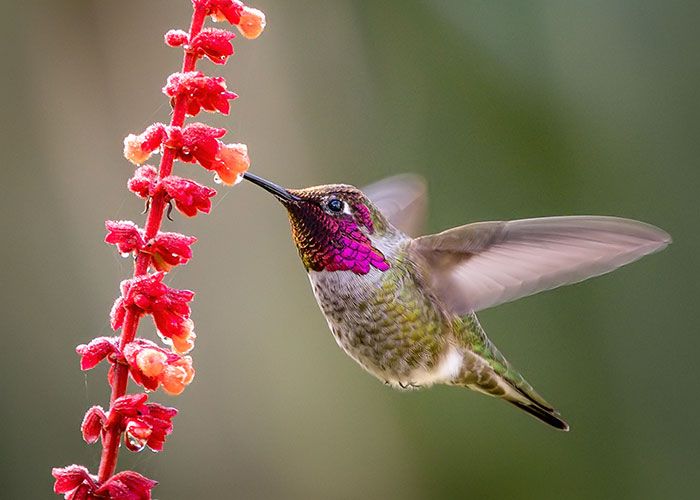
2.) Anna’s Hummingbird
Anna’s hummingbirds are a rare hummingbird species in the eastern region of America. They are occasionally spotted in Ohio, however they’re native to coastal regions of North America. They’re around 10-11 cm in length and a 12cm wingspan, an average size of the birds.
The belly and the chest are colored in grey, the back iridescent bronze-green and green flanks. They also have red crowns. Their throats are colored in red, but less bold on the female. Their bill is straight, slender, and long. They use their tongue to feed on nectar. Anna’s hummingbirds consume tiny insects and arthropods.
They are famous for how they behave when defending territories. Contrary to males in other hummingbird families, Anna’s males are noisy. The males create series of complex scratchy noises as they feed or mark territories.
Anna’s hummingbirds will be spotted in the months of winter but do not breed in Ohio.
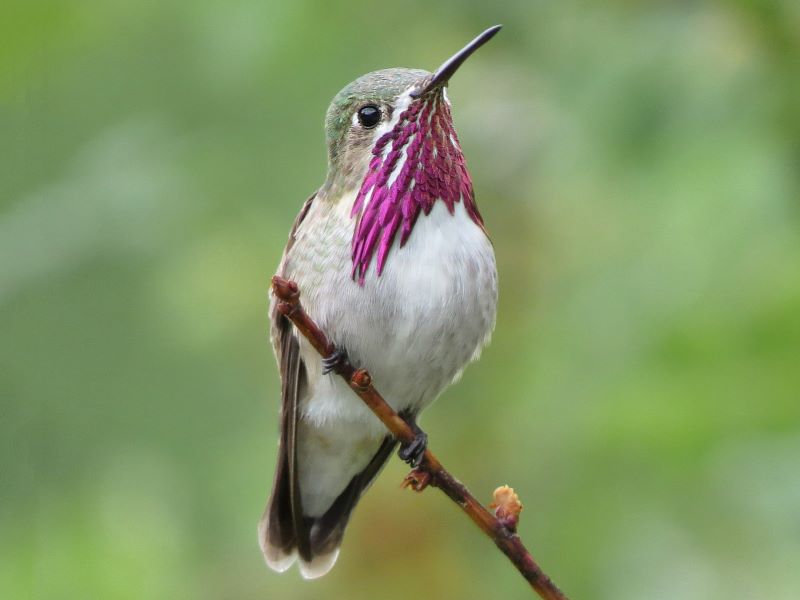
3.) Calliope Hummingbird
Calliope hummingbirds are a rare hummingbird visitor of Ohio. They have green backs and crowns and white from below. Female and young Calliope hummingbirds have pinkish flanks, dark tails with white tips, and dark streaks around the throat. On the other hand, Males have green flanks, red streaks around the neck, and a dark tail.
Calliope hummingbird measurements range from 7-10cm in length and wingspan of 11cm. They are native in areas with open shrubs and high altitudes where the climate is favorable for bleeding. They are categorized among the smallest migrating birds in America. They leave their breeding grounds early to gain an advantage to feed on nectar in late-summer flowers. They use their long extendable tongue for drinking sap from flowers. They also feed on small insects.
A male will arrive earlier to claim a nesting territory. During courtship, they create a buzzing sound by hovering at an increased rate of wing flapping. Different feathers are flapped and convey different messages to attract and appeal to a female. A few have been spotted in spring and fall visiting a bird’s feeder in spring and fall in Ohio.
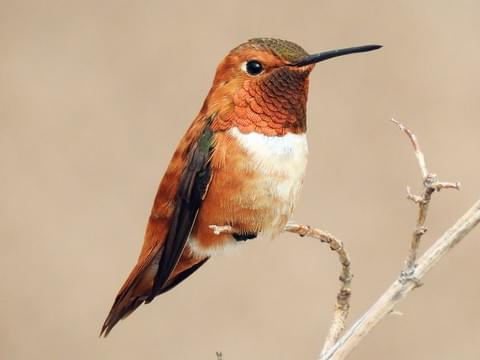
4.) Rufous Hummingbird
The rufous hummingbird is a mall species of hummingbird with a bill that is long, straight, and slender. It is 7-9cm in length and a wingspan of 11cm. It can fly over 2000 miles when migrating, and this extraordinary quality has made it popular among other hummingbirds. An adult male rufous hummingbird has an iridescent reddish-orange patch around the throat, and Females are rufous-colored at the base, dark tail with a white tip, and white and green feathers at the throat. A Rufous male is slightly smaller. It is green on the back, and it won’t be easy to differentiate them from Allen’s hummingbirds. Rufous males rarely have greenbacks.
These hummingbirds use their wing to trap insects and consume them. Their main source of food is nectar from flowers. Due to their small size and high metabolism, they frequently feed during the day. At night they stay in a dormant state to conserve energy. They are vulnerable to predators who feed on insects and small birds.
Both males and females are territorial and chase away intruders by flapping their wings at a high frequency. Males become aggressive and chase females to less sparsely distributed flowers. It is native in mountainous areas, and that is where it breeds before migrating to other areas. They arrive in Ohio in early may and depart in late September.
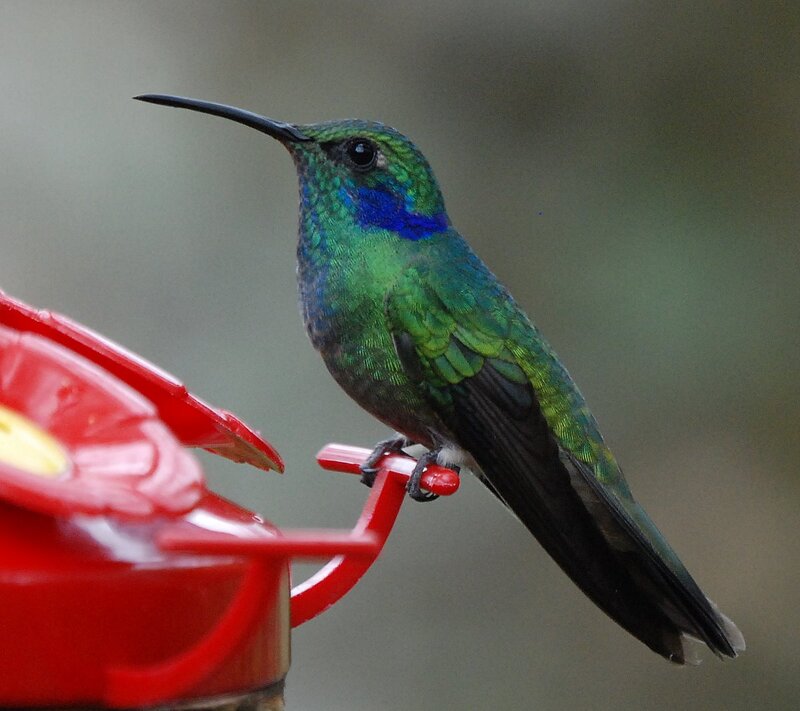
5.) Mexican Violetear
The Mexican Violetear is a native bird in forested areas in America. It measures between 9.7-12cm in length and a 12cm wingspan. Their bill is black and slightly curves downwards like a few other hummingbirds. Compared to the rest of the hummingbird family, it is considered to be a medium-sized bird. It is metallic green on most of the body parts with a blue-green tail. Males sing in their territories repeatedly each day.
It is a non-breeding rare visitor in Ohio and other states in America. However, they are native in tropical highlands found in Mexico to Nicaragua. They feed on nectar and insects. On many occasions, a Mexican Violetear will forage alone, but you can find several of them in deforested areas with flowery trees. Their migration patterns are complex and not easy to understand.
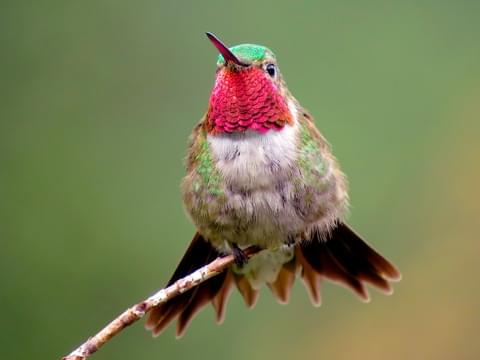
6.) Broad-tailed Hummingbird
The broad-tailed hummingbird is one of the hummingbirds in Ohio that you’ll frequently see sampling the local nectar. The broad-tailed is medium-sized species in the family, measuring 10cm on its length and 13.3cm on the wingspan. Females are slightly larger compared to male species. They are iridescent green color on their backs, white around the eye, and a rounded tail black in color. A male has a red throat patch, while the female has a more pale coloration.
Broad-tailed hummingbirds produce sounds and beat their wings to communicate. During courtship displays, the male’s wing beating is loud and can be heard by males and females 50m and 75m away, respectively.
It breeds in central Montana and migrates to other areas. It is an accidental visitor in Ohio.
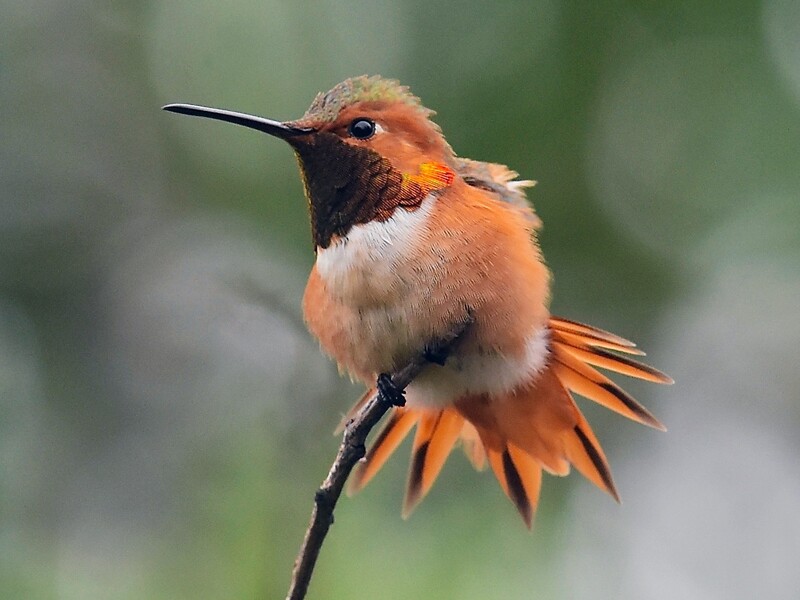
7.) Allen’s Hummingbird
The Allen’s hummingbird is a small bird measuring 0.76-0.89cm in length. The males are green colored in their back and forehead, rufous tail, flank and rump, and orange-red throat patch. The female and young hummingbirds lack the orange-red patch around their necks.
They are native of Coastal California. They are similar to the Rufous species, especially the females. They usually migrate south, and you might occasionally spot one of these hummingbirds in Ohio.
BONUS: How to attract hummingbirds to your yard
A lot of people make inquiries about the right time to place feeders outside. Placing the hummingbird feeders around your home is important because the hummingbirds remember when they are migrating again. But it cannot be the only thing as the birds feed primarily on nectar and will visit areas with flowers more frequently and inhabit the areas during migration. They have a weak sense of smell but respond quickly to brightly colored flowers.
• Replacing old hummingbird feeders
Birds need nutrients to boost energy for rapid metabolism. Supply them with a variety of supplements that contain the right nutrients and insects. After feeding on nectar on flowers, they will get another energy source by feeding on the supplements.
• Practice the right gardening
There are various benefits of planting the right vegetation in your backyard garden. The flowers produced by the plants will attract and provide nectar for the hummingbird. Insects and arthropods are found in the vegetation, and the hummingbirds consume them. It is important to avoid spraying the plants when the hummingbirds are migrating in the area. It would kill the insects and harmful to the birds.
They also need shelter, and the plants provide a place to build their nest. They can perch on and hide from rain, predators, wind, or sum and feel secure. It is advisable to leave cobwebs and crowded vegetation in their migration season so that they can quickly build their nest.
Planting plants with red and orange colored flowers is an added advantage.
• Add non-plant colored materials around your home
You can tie ribbons around trees in your garden. The feeder can also have bright colors to ensure it catches hummingbirds’ eyes when they are passing.
• Watch out for bigger birds and predators
When you provide water and supplement on the hummingbird feeders, other larger birds and predators might scare them away, preventing them from staying in your compound. You must keep them away and let the hummingbirds enjoy their stay around your home.
• Provide water and self-made nectar
Water is essential for every living organism. Making a sugary solution for hummingbirds is an easy process. Some individuals prefer it premade, but many people make a solution at home since the process is simple. There are a couple of things not to add to the solution, including natural honey but do not let your birds go without nectar.
• Clean and strategically place your feeds
You should refill feeders often, but you must clean them each time you want to refill. Make sure you buy durable feeders that are brightly colored and place them in safe places. The feeders should be accessible by hummingbirds and keep away rodents and insects. Feeders should be in variety to be efficient for a large number of hummingbirds.
For a more in depth article on how to attract hummingbirds, check out how to turn your backyard into a hummingbird sanctuary.
Hummingbirds in Ohio are a sight to behold. If you are interested in birding or already an expert birder, watch out for them in the spring and fall months.
Related
- Ever seen two hummingbirds chase each other before? In one of our recent articles about hummingbirds, we explore why they tend to do this. There’s a lot more that meets the eye when it comes to these little creatures!
- Birds are so common, we see them everyday. Sometimes, we might wonder how similar they are to us: like for example, where do they sleep? Check out our article where we explore where hummingbirds tend to sleep, and their accompanying sleep habits.
Links
https://www.beautyofbirds.com/hummingbirdsohio.html
https://www.birdwatchersdigest.com/bwdsite/learn/hummingbirds/attract.php
https://en.wikipedia.org/wiki/Hummingbird
Leave a Reply